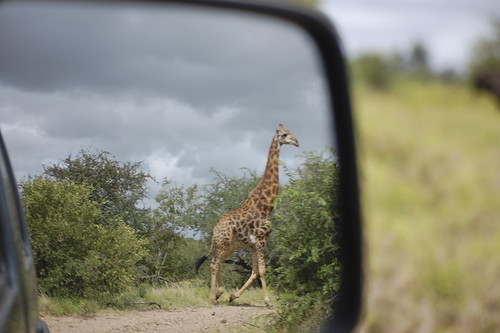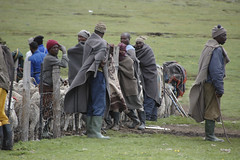After a difficult border crossing with the Zimbabwean customs agents telling us we did not have the proper paperwork for our Sani, we finally made it into Zambia. My guess is that they were trying to find something to charge us for, but eventually gave up and just let us go. We set off into Zambia with a sigh of relief to be out of Zimbabwe. It hasn’t all been bad in Zimbabwe, the people seem very friendly. In fact, on our way into the country, we met a Zimbawean also crossing the border who helped us at customs and gave us his phone number in Harare, offering to show us around. For the most part, it’s hard to criticize the Zimbabweans for what they have to resort to in order to make money. It must be difficult to live under a government where corruption is not only condoned, it’s rewarded. I don’t imagine most people want to use deception to make money, but it’s the only way.
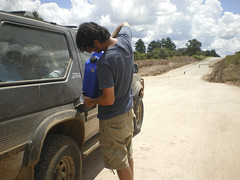 Well, we thought we were free and clear in Zambia, knowing we could get gas anytime we want, little did we know…Thirty km or so after the border crossing, the truck wasn’t running very well–not accelerating over the hills, and sputtering. Another 5km pass, and on the way up a hill, the engine cuts off, and we roll back down onto a bridge that is a construction site. By this time we realize that we are out of gas, which doesn’t seem possible considering the 80L we just put in at the border should take us about 600km. I can’t confirm this, but it’s likely we paid $140 and didn’t get any gas in Zimbabwe. The construction workers come to see why we are stopping on their worksite. And Mike learns that the nearest town is about 8km. He hitches a ride with a jerry can in hand. Only about 6 cars pass before someone is willing to give him a lift. According to Mike, he got in and they cranked up the radio, and didn’t say a word. He returned an hour later with gas, and we were on our way, again.
Well, we thought we were free and clear in Zambia, knowing we could get gas anytime we want, little did we know…Thirty km or so after the border crossing, the truck wasn’t running very well–not accelerating over the hills, and sputtering. Another 5km pass, and on the way up a hill, the engine cuts off, and we roll back down onto a bridge that is a construction site. By this time we realize that we are out of gas, which doesn’t seem possible considering the 80L we just put in at the border should take us about 600km. I can’t confirm this, but it’s likely we paid $140 and didn’t get any gas in Zimbabwe. The construction workers come to see why we are stopping on their worksite. And Mike learns that the nearest town is about 8km. He hitches a ride with a jerry can in hand. Only about 6 cars pass before someone is willing to give him a lift. According to Mike, he got in and they cranked up the radio, and didn’t say a word. He returned an hour later with gas, and we were on our way, again.
Zim and Zam
February 23rd, 2008Mana Pools NP
February 22nd, 2008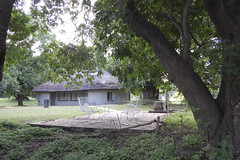 We had no intention of spending more than one night in Zimbabwe(which we did at the Holiday Inn at Mutare), but then at the last minute we decided to detour to Mana Pools National Park, where there are no fences between you and the animals. It’s noted for it’s great beauty, and therefore a UNESCO World Heritage site. The park is off the main highway and one of the last stops before the border of Zambia. We arrived at the park office around 5:30pm, and received approval to head to the gate and into the park (the gate usually closes at 3:30pm). Once we arrived at the gate, we were told it was another 30km on a potholed dirt road to the checkpoint. After an hour we arrived, and were told to continue on another 45km to the campsite. Looking at the fuel gauge, we figured we had enough to get to the campsite and back with just a little to spare.
We had no intention of spending more than one night in Zimbabwe(which we did at the Holiday Inn at Mutare), but then at the last minute we decided to detour to Mana Pools National Park, where there are no fences between you and the animals. It’s noted for it’s great beauty, and therefore a UNESCO World Heritage site. The park is off the main highway and one of the last stops before the border of Zambia. We arrived at the park office around 5:30pm, and received approval to head to the gate and into the park (the gate usually closes at 3:30pm). Once we arrived at the gate, we were told it was another 30km on a potholed dirt road to the checkpoint. After an hour we arrived, and were told to continue on another 45km to the campsite. Looking at the fuel gauge, we figured we had enough to get to the campsite and back with just a little to spare.
By this time it’s dark out with still the last 20km to go, we run into an elephant bull in the middle of the road side. Rather than move back into the bush, the elephant decides to walk towards us, and keep walking towards us. Mike backs the car up, but he keeps following us. His ears are flapping, and is aggressively shaking his trunk. He backs us up about 1km, and by this time we decide we need to take action, as this elephant won’t give up. At one point, the elephant is slightly off to the side of the road and we decide this is our chance to get past. As we inch forward, the rogue elephant moves its body back into the road. Mike guns the engine, but forgets to shift gears, so the engine is roaring, and the elephant rears on its hind legs and jumps right into the bush. We were scared,and so was the elephant who went tearing into the bush. (It was kind of funny in the end, and I felt sorry for the elephant, too).
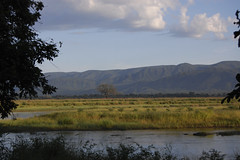 Initially we planned to camp, as they said there were no cabins available, but when we arrived, it was pitch black(and not possible to make camp), so we were offered lodging in a chalet. The guide told us the price, but said for us he would give the South African rate (which was half price). The way he gave us the offer Mike and I both knew he planned to pocket the money. It’s off-season at Mana Pools, and we were the only guests in the entire park. Eventhough we had a thatched chalet, the accommodations were rundown — the door was a gate, the windows had no glass, only chicken wire and a screen. Giant spiders lived inside. No running water. I slept in a twin bed, suffocating from the heat of the night with the mosquito net tucked under the mattress. All night we heard an orchestra of sounds– peacocks cackling, monkeys calling each other, hippos grunting, and an elephant trumpeting.
Initially we planned to camp, as they said there were no cabins available, but when we arrived, it was pitch black(and not possible to make camp), so we were offered lodging in a chalet. The guide told us the price, but said for us he would give the South African rate (which was half price). The way he gave us the offer Mike and I both knew he planned to pocket the money. It’s off-season at Mana Pools, and we were the only guests in the entire park. Eventhough we had a thatched chalet, the accommodations were rundown — the door was a gate, the windows had no glass, only chicken wire and a screen. Giant spiders lived inside. No running water. I slept in a twin bed, suffocating from the heat of the night with the mosquito net tucked under the mattress. All night we heard an orchestra of sounds– peacocks cackling, monkeys calling each other, hippos grunting, and an elephant trumpeting.
The next morning we woke up to birds chirping softly and viewed the beauty of Mana Pools, so different during the day than at night.
traffic violation
February 22nd, 2008After adding fuel to the tank, we headed off again. We made it to the city limits of Karoi, and I got pulled over by the police. We were informed I was speeding, going 80km/hr in a 60km zone. Rather than ask for our license and registration, he asked us where we were from. We said Cape Town, and he asked us how much Rand we brought him from South Africa. Rather than negotiate, we just gave him 100R for each of the officers on duty. He actually seemed relieved, and very grateful for the money. (We heard some government jobs have gone without pay, meanwhile Mugabe is celebrating in style for his birthday.)
Zimbabwe
February 22nd, 2008We’re heading to Victoria Falls from Mozambique, and the most direct route is to cut straight through Zimbabwe. The situation in Zimbabwe is unfortunate, though, and we seriously considered driving hundreds of kilometers out of our way in order to avoid the country all together. Then we spoke to a few Zimbabweans, and they all reassured us that the country might be a mess, but that we would be safe. Inflation continues to rise, with a loaf of bread costing upto 50,000,000 Zim Dollars (or $5USD), and continued sanctions on Zimbabwe make daily life difficult which increases the need for a black market. Our planned route was to go from the eastern border of Mutare, drive through Harare(the capital), and exit Zimbabwe on the western border of Chirundu–the distance of 600kms.
The lack of fuel tends to be a problem for any road trip in Zimbabwe. When we entered the border, a Zimbabwean man informed us that there was no fuel in Harare, but they were hopeful the petrol trucks would arrive the next day. The shortage of fuel is typically for unleaded gas, not diesel. As you drive by the gas stations, they have a sign out front that says “diesel” and “petrol” with a “yes” or “no” next to it written in chalk.
A few hours later, when we arrived into Harare it appeared they did get their delivery of petrol, and Mike and I figured that meant the country had gas, so we kept driving. Then we took a wrong turn, and ended up adding another hour to our drive. By the time we had driven halfway through, I decided we should stop in Karoi to fill up. But there was no petrol in Karoi, except for the farmers. The attendant at the station suggested we try the black market. So, I asked where was it? A man seated next to her stood up, and voila! we were back in business. Rather than $1.40/L, we were charged $2.00/L. Most of the Zimbabweans prefer US Dollars, not Zim Dollars. We bought 50L.
From the petrol station, we drove this man into a back street of a neighborhood, where another car followed us that had a large plastic barrel of gas sitting in the back seat. They told us that all of the stores in town had closed down, there are no jobs left, and the only way to make any money is through the black market. They pay truck drivers to fill their second gas tank with petrol from a neighboring country. There is even a fixed price for black market gas, the man helping us was called by another black market to raise his price because he was undercutting his competition. This man sincerely wants a job where he knows he will earn a paycheck at the end of each week, but he’s not hopeful that will happen any time soon.
an island paradise all to ourselves…
February 18th, 2008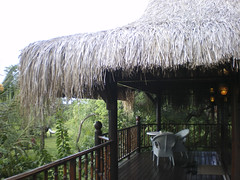 It turns out we were one of the few guests at the island resort, as it is the low season. That was fine for Mike and I as the weather was terrific, the water was crystal clear, we had an amazing chalet complete with outdoor shower, we had the entire beach, and restaurant to ourselves! And even more importantly(for Mike), we had high speed internet.
It turns out we were one of the few guests at the island resort, as it is the low season. That was fine for Mike and I as the weather was terrific, the water was crystal clear, we had an amazing chalet complete with outdoor shower, we had the entire beach, and restaurant to ourselves! And even more importantly(for Mike), we had high speed internet.
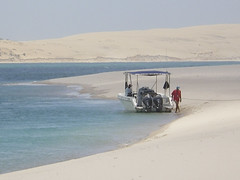 Besides swimming in the salt water endless pool, we also went diving, again. The diving here was reported to be just as good, or better than Tofo. We dove at 2 mile reef, and unfortunately the visibility was about 1-2 meters, and the swell underwater was pretty strong. But that didn’t stop us from seeing lots of marine life, and excitingly, hawksbill turtles.
Besides swimming in the salt water endless pool, we also went diving, again. The diving here was reported to be just as good, or better than Tofo. We dove at 2 mile reef, and unfortunately the visibility was about 1-2 meters, and the swell underwater was pretty strong. But that didn’t stop us from seeing lots of marine life, and excitingly, hawksbill turtles.
(photo: a stop over at Pansy Island between dives)
flying high!
February 17th, 2008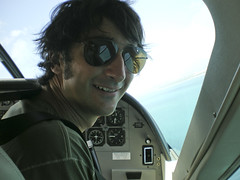 After sorting out the car, we made our way to Vilanculo, where we caught a flight to Bazaruto Archipelago, the ‘quintessential tropical paradise’ for some R&R. We took a 15 minute flight on a 20 seat Cessna over to the island. As it turned out we were the only two passengers on the flight, and Mike got to sit in the front and co-pilot the plane.
After sorting out the car, we made our way to Vilanculo, where we caught a flight to Bazaruto Archipelago, the ‘quintessential tropical paradise’ for some R&R. We took a 15 minute flight on a 20 seat Cessna over to the island. As it turned out we were the only two passengers on the flight, and Mike got to sit in the front and co-pilot the plane.
fuel crisis
February 16th, 2008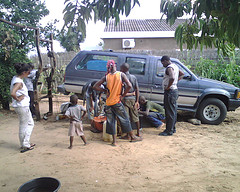 From Tofo we drove north to Vilanculos before heading to the Bazaruto Archipelago, a tropical island get away. It should have been a pretty straight forward drive along the coastline, but it turned into an adventure…
From Tofo we drove north to Vilanculos before heading to the Bazaruto Archipelago, a tropical island get away. It should have been a pretty straight forward drive along the coastline, but it turned into an adventure…
We were in a small town, where the ´dot´ on the map is barely visible, and likewise the town had nothing much going for it besides two gas stations. We stopped for gas, and ended up with fuel pouring out of the bottom of the truck. The locals speak Portuguese and their indigenous language, and most do not speak English. So we asked the gas attendant for a mechanic, and he says no. I was in a panic, we just filled up our 40 gallon tank, there was already a pool of gas under the truck, and I was imagining someone striking a match. So, we head to the other gas station, and ask for a mechanic, and we are told to follow these kids who will take us to the mechanic.
Rather than a service station, we find ourselves in someoneś front yard. And in order to drive into the yard, we had to engage our 4×4. You see, whether or not a family has a brick house or a wood rondavel, the yard mostly consists of a few trees, maybe a few crops (corn or sugar cane) and sand. There is no grass or lawn, just sand. We park the car in front of two steel poles that they use as sort of a ´crane´ to lift up the back end of the car.
So, already itś a strange scene, but when we figure out the mechanic is 15 years old and his five assistants range from the ages of 8-17years old, it gets even more strange. The ´mechanics´ have to drain the fuel from the tank in order to remove the fuel tank from the truck, and they do this by collecting every plastic bucket around the house. They discover the problem is with the ´seal,´ which was poorly sealed when we got the new fuel tank at Komatipoort before leaving South Africa. The mechanic creates a new seal by using a piece of old cardboard box and using a screwdriver to cut out a circle, and putting silicone glue between the two sides before putting the lid back on and screwing it back into place.
Meanwhile, the family (3 women, one grandmother, 3 children and one uncle) invited us to eat lunch with them. We said yes, but thought this would probably mean we will get sick. Lunch was similar to Indian saag (a kind of creamed, chopped spinach, but without any spices, and some sand grits) and rice. After lunch, the two girls played hopscotch in the dirt yard, and the little boy played ´cars´ with an old plastic tub of margarine and an old lightbulb box in the sand.
After about 3 hours, the gas tank is reassembled and back under the truck, and the fuel back in the tank. Now, it was a matter of whether the car would start or not. It didn´t. They go back under the car, and switch two tubes. Then it starts! If you saw this auto-shop in the states, you wouldn´t even stop if your car were on fire. But these kids fixed the problem. We paid them, and also gave the mechanic a boogie board. They were so happy with the boogie board, they picked the mechanic up over their heads, like a hero!
diving in Tofo
February 14th, 2008 Depending on where you are in Mozambique, the road quality can vary greatly. Some of the tar roads are in excellent condition, then all of a sudden, there might be a 30mile stretch where the potholes are big enough to swallow your tire and crack your axle. Fortunately the roads are not busy, so itś feasible to zig zag between both lanes to avoid the potholes, or even drive off the side of the road. And during some stretches, kids will fill in the potholes with dirt, and ask for money for their service.
Depending on where you are in Mozambique, the road quality can vary greatly. Some of the tar roads are in excellent condition, then all of a sudden, there might be a 30mile stretch where the potholes are big enough to swallow your tire and crack your axle. Fortunately the roads are not busy, so itś feasible to zig zag between both lanes to avoid the potholes, or even drive off the side of the road. And during some stretches, kids will fill in the potholes with dirt, and ask for money for their service.
Getting to Tofo required us to take a few poorly maintained roads, but we got there all the same. We stayed in a nice A-frame chalet, only meters from the beach, and spent two days diving. 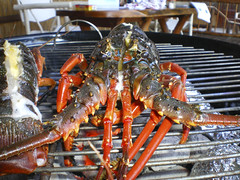 The diving was fantastic, with high visibility, and great sea life. We dove the manta reef, which as itś name suggests, there were manta rays. The mantas we saw were 18 feet or so, but they can grow up to 25feet and can weigh as much as 5000lbs. Watching them puts you in awe. They are so graceful and such beautiful creatures of the sea.
The diving was fantastic, with high visibility, and great sea life. We dove the manta reef, which as itś name suggests, there were manta rays. The mantas we saw were 18 feet or so, but they can grow up to 25feet and can weigh as much as 5000lbs. Watching them puts you in awe. They are so graceful and such beautiful creatures of the sea.
During the day, the locals walk up and down the beach selling fresh fish– prawns (tiger shrimp), baracuda (spanish mackarel), and crayfish (lobster). We bought a few crayfish and had a delicious braii (bbq).
“I want MON-NEY”
February 13th, 2008Other travellers’ who had been to Mozambique warned us that we would likely be pulled over by the police at some point during our stay in Mozambique. We barely made it passed border control and the first toll plaza, and we were pulled over…
We hand over our South African license, and the policeman says what we have is not a license. And that we are driving illegally. And it is” Big, Big trouble, my friend…” “up to six months in prison…” “We will need to go to Maputo to the jail…” “it will cost you very much…”
Now, while we were in South Africa we’d been pulled over a few times at random check points and never had a problem showing them our South African license. Usually after a friendly chat, we were free to go.
For some reason, the police in Mozambique would not accept our South African license. Six other officers were standing around, out of earshot from us pretending nothing out of the ordinary was happening… Actually, nothing unusual was happening. They know what their fellow officer is doing. They are just waiting for their turn to “shake down” another tourist in order to make some extra cash.
We politely asked him what we could do to make the problem go away. The Moz officer said he wanted “something”. Then he actually walked around our truck to look into the back to see if there was something in the back he might want. We pretended we didn’t know what he wanted… Maybe he was hungry. I have lots of snacks.
But then he said ” I want mon-ney”. Pretty specific. Wish I had a tape recorder. He also specified how much, which ranged from 200 to 1000 rand($26-$130).
The ordeal went on for quite some time, and he held onto our documents, so we couldn’t go anywhere. He actually called another officer over, and she also confirmed there was a problem. Finally we said we had the number to the US Embassy, and we were dialing. He finally started to panic, we gave him 200Rand and got our passport and license back.
I guess this is what people mean when they say, once you leave South Africa, you’ll see “the real Africa.”
The Kruger
February 12th, 2008Four days at Kruger, and we still hadn’t seen the big 5. We’d taken many self-drives (where you can drive yourself around the park) including a 4×4 trail– in total covering about 500km traveling about 40km/hr (the speed limit in the park), which is over 12 hours of driving and we never even saw the entire northern half of the park. In addition, we went on a few evening tours, which was about another 5 hours of searching for the big 5.
Three of the big 5 are fairly easy to spot– elephant, buffalo, rhino. Number 4, the lion isn’t easy to spot, but in the evenings, they seem to hangout on the tar road. I guess it retains some of the heat from the day, and the cats like to warm up on it. In addition we saw tons of kudu, impala, steenbok, zebra, wildebeast and giraffe. Warthogs, jackals, hyenas, hippos, wild dogs, chacma baboons, crocodiles, water monitors, and vultures and tons of smaller birds. We did not see number 5, the leopard who is shy, and therefore difficult to spot.
The wildlife is amazing. We saw many different things; giraffes “neck” fighting, zebras mating, rhinos yawning, wildebeest marking their territory, baboons grooming each other, hyenas eating feces, a baby zebra nursing, a lion calling out to his mate, the remains of a kill (bones were picked clean, only a small strip of the zebra hide remained), elephants playing in the water, lions hiding out in the shade. And we learned random facts; the white rhino has poor eyesight, elephants are overpopulated in the park, giraffe sex between males is common, the impala is “fast food” for the lions, female buffalo prefer the young bulls and kick out the old male buffalo, the wildebeest is not a smart animal, giraffes only sleep 20 minutes per day.
After a great time at Kruger, we were ready to head into Mozambique when we discovered we had a leak in our fuel tank. Fortunately we discovered this in South Africa and not after crossing the border. We ended up staying 2 more nights at the border of town of Koomatiport at a nice lodge over looking the Crocodile River, where in the evenings you can hear the hippos calling out to each other.
don’t be fooled by their innocent demeanor…
February 6th, 2008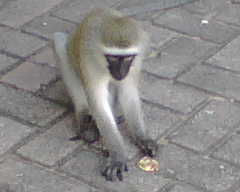 Okay, so I thought it couldn’t get worse. First the sharks, then white rhino, then the wild dog, and then…
Okay, so I thought it couldn’t get worse. First the sharks, then white rhino, then the wild dog, and then…
…We finally get to Kruger, and while Mike is at reception, I got lured out of the car by this cute vervet monkey. While my attention was diverted and I had my back to the car, it gave my attackers the perfect chance to make a break for the car. By the time I figured out what was going on, two other vervet monkeys went through the open windows and were rooting through the truck in search of food.
I run back to the car to get them out, but I have no idea how. No one ever prepared me for this. So, I shoo’d them to get out and stuck my hand in the car. That did not go over well. While the one monkey continued to look for food, the other one jumped out at me, barred its teeth, and swiped at me. Then jumped back in the car. So then I yelled at them, honked the horn and was met with the same response– teeth barring and swiping.
Finally some people came by, and with their help I managed get the monkeys out of the car. I was actually a bit shaken up by the whole experience. The bandits might have been tough, but all they managed to get away with was a pack of instant soup.
wild dog!
February 4th, 2008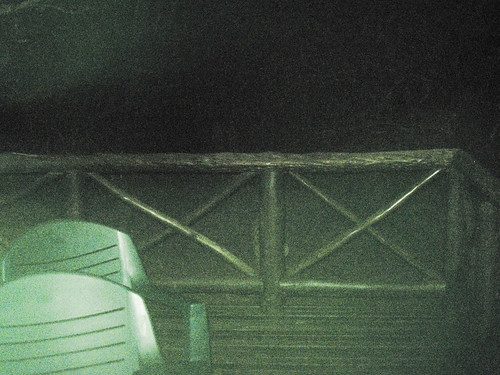
(photo: our view from our tent)
After St. Lucia, we went to uMkuze Game Reserve and stayed the night in a safari tent. These tents have electricity, bathrooms and an open-air kitchen. And unlike at Kruger, which has enclosed campsites (ie. An electric fence to keep out animals), uMkuze does not. During the day, I was taken by the sight of impalas grazing on our front lawn, but at night I was a bit terror stricken…
At 1:30am, we were woken up by the sound of the trash can in the kitchen being knocked over.
Now, this happened to me in college, and my roommates and I trapped our trash picking racoon using an animal trap with a piece of chocolate cake as bait. The next day, we turned the racoon over to the SPCA, and that was that.
For some reason, I first thought of that of the racoon when I was startled awake. Then I realized we were in the wild. We had no neighbors, and no one told us what to do in case of emergency! So when we heard the noise, we got the flashlight out, and peered outside our tent. Whatever was outside, it was tan and spotted and staring in at us. It was dark…and Mike said it was a leopard. But we determined, a leopard wouldn’t bother with a trashcan when we were in the tent. And the only thing stopping it from coming in was a mesh net door, and it was pacing back and forth. It walked up onto our deck, walked past our tent into the kitchen.
Turns out it was a wild dog. We spoke with someone the next morning, who said it was a rare sighting, and we should feel lucky. I didn’t tell the guide, that our wild dog was really rare, since it liked Mexican food. The only thing the dog walked away with was an empty box of El Paso taco mix.
rhino charge!
February 3rd, 2008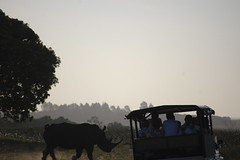 We just barely made it out alive from the shark attack, but since then, each day we’ve had an incident, or so to speak…After diving in Scottburgh, we went to St. Lucia Estuary for turtle viewing. Between November and February each year, the loggerhead and leatherback turtles come to the shores of St. Lucia to lay their eggs. We eagerly signed up for a tour, but did not see any turtles. Instead, we had a white rhino, take notice of us, and charge us. I guess we were infringing on his space, and he wanted us to know who is boss. These beasts mean business when they charge. First off they weigh up to 5000lbs., and they can get up to 25 miles an hour. Lucky for us, our tour guide backed us out of the situation, and the white rhino had it’s territory, thus its honor restored.
We just barely made it out alive from the shark attack, but since then, each day we’ve had an incident, or so to speak…After diving in Scottburgh, we went to St. Lucia Estuary for turtle viewing. Between November and February each year, the loggerhead and leatherback turtles come to the shores of St. Lucia to lay their eggs. We eagerly signed up for a tour, but did not see any turtles. Instead, we had a white rhino, take notice of us, and charge us. I guess we were infringing on his space, and he wanted us to know who is boss. These beasts mean business when they charge. First off they weigh up to 5000lbs., and they can get up to 25 miles an hour. Lucky for us, our tour guide backed us out of the situation, and the white rhino had it’s territory, thus its honor restored.
Understand you’re having a little shark trouble.
February 2nd, 2008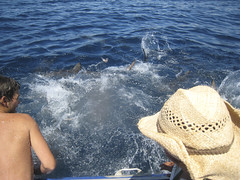 While we were in Bulungula, we met a guy who told us about Blue Wilderness. These guys specialize in shark diving. We already knew about a type of shark diving in Cape Town where you don’t really dive, you just have a mask and a snorkel, and they lower you just below the surface in a cage, while they dangle bait in front of you. The Great Whites come to chow down, and apparently it’s quite a show.
While we were in Bulungula, we met a guy who told us about Blue Wilderness. These guys specialize in shark diving. We already knew about a type of shark diving in Cape Town where you don’t really dive, you just have a mask and a snorkel, and they lower you just below the surface in a cage, while they dangle bait in front of you. The Great Whites come to chow down, and apparently it’s quite a show.
Blue Wilderness does something a little different. They let you actually scuba dive with the sharks. That means no cage. No protection. No sh*t. Tiger sharks are what they’re looking for here. They’re big. 8-10 meters and they have stripes like, you guessed it, a tiger. More abundant are Black Tips which are much smaller, and have black tips on their fins. There’s also Whale Sharks, which are as big as a…you get the picture.
Oddly enough, the thought of jumping into shark infested water didn’t seems that crazy to us. They’ve been doing this for 10 years without any accidents. We were also diving with Mark Thorpe, a National Geographic videographer, who’s been working on a documentary about tiger sharks for the last 3 months and has done the dive 30 times so far. More importantly, no one in the crew seemed to have any prosthetic limbs, so we took that as a good sign.
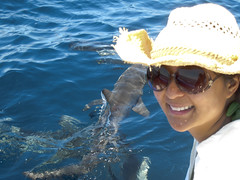 Now keep in mind Christine just learned to dive 4 months ago. Ditto for learning to swim. Before that, she had a great fear of the ocean, and especially of everything that lives in the ocean that’s not already been grilled and served with butter. So who’s the last person you’d expect to be jumping in the water with 50 sharks?
Now keep in mind Christine just learned to dive 4 months ago. Ditto for learning to swim. Before that, she had a great fear of the ocean, and especially of everything that lives in the ocean that’s not already been grilled and served with butter. So who’s the last person you’d expect to be jumping in the water with 50 sharks?
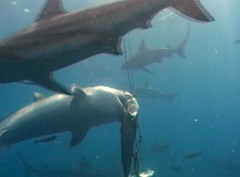 Mayhem is the best way to describe the scene under water. There’s sharks everywhere around you, above you, below you. When they swim at you, it’s quite startling. Especially the tigers. They almost always turn before they get to you, or if they get too close, they tell you to simply push them away. That’s right, with your own hands. Luckily there was no need for either of us to do that. We let the guys with the giant under water cameras in front of them handle it
Mayhem is the best way to describe the scene under water. There’s sharks everywhere around you, above you, below you. When they swim at you, it’s quite startling. Especially the tigers. They almost always turn before they get to you, or if they get too close, they tell you to simply push them away. That’s right, with your own hands. Luckily there was no need for either of us to do that. We let the guys with the giant under water cameras in front of them handle it 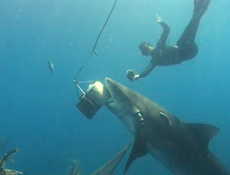 The sharks are obviously mostly interested in the bait buffet which gets refilled by a brave guy who free dives 10 meters down with just a mask and fins. And if that wasn’t enough, they are also tossing in sardines from the boat above you just to keep things hopping.
The sharks are obviously mostly interested in the bait buffet which gets refilled by a brave guy who free dives 10 meters down with just a mask and fins. And if that wasn’t enough, they are also tossing in sardines from the boat above you just to keep things hopping.
In all, there were 5 Tiger Sharks and about 50 Black Tips. Once back in the boat, they toss in some sardines at the surface so Mark could get some shots of the feeding frenzy. On the way back we spotted a few whale sharks which are like 20 meters long and very peaceful. The only eat plankton. They are quite a site to see under water.
In related news Roy Scheider, went into the deep blue this week.
Here’s some video of our dive. You can see me in there around 1:20.
[youtube]http://www.youtube.com/watch?v=2Ko5D3ZKOAE[/youtube]
medieval knights in Lesotho??
January 30th, 2008my little pony, Duke
January 30th, 2008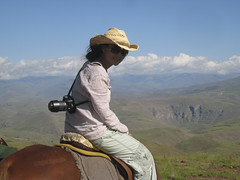 Once in Lesotho we headed to Molumong, which is about two hours from the Sani Pass, for some pony trekking. We stayed at an old trading post, now converted into a backpackers lodge. We only went pony trekking for 3 hours, which turned out to be just long enough to see the countryside, and just short enough to be sore the next day, but still be able to walk. My horse, Duke was gentle, but didn’t really listen to commands. No matter what I did, he just followed the other horses. So, if the other horses started to gallop, than Duke would gallop. Even if I didn’t want to, I had no choice but to hold on.
Once in Lesotho we headed to Molumong, which is about two hours from the Sani Pass, for some pony trekking. We stayed at an old trading post, now converted into a backpackers lodge. We only went pony trekking for 3 hours, which turned out to be just long enough to see the countryside, and just short enough to be sore the next day, but still be able to walk. My horse, Duke was gentle, but didn’t really listen to commands. No matter what I did, he just followed the other horses. So, if the other horses started to gallop, than Duke would gallop. Even if I didn’t want to, I had no choice but to hold on.
the Sani Pass
January 29th, 2008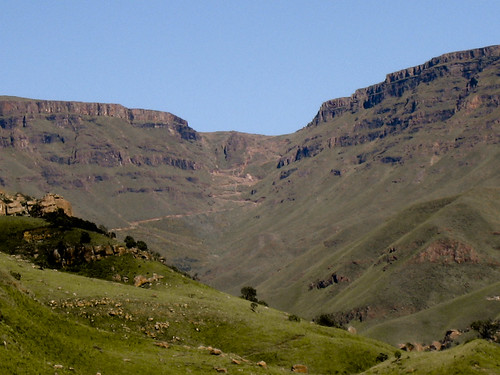
Drakensburg National Park is 243000acres, which means when you are in the park, as far as the eye can see in any direction, you are surrounded by the beauty of it. There are endless peaks and valleys. It’s green and lush, and wild. Before crossing into Lesotho, we decided to stay at the bottom of the Sani Pass and do a morning hike in Drakensburg. The trail was a 5 hour hike, which took us past a few nice waterfalls, and fresh water pools. The following day, we drove the Sani Pass into Lesotho. Years ago the Basotho people would travel on horseback from their country of Lesotho into South Africa to buy/trade supplies. The typical trip would take one week from Mokhotlong(in Lesotho) to the bottom of the pass. The road conditions are much better than in the past, which isn’t saying much. Only 4×4 vehicles are permitted to drive up the Sani Pass. It takes about 4 hours, which includes border control and a stop at the highest bar in Africa, the Sani Top Chalet.
Pulling mussels from a shell
January 24th, 2008[youtube]http://www.youtube.com/watch?v=upjxtI8bB0c[/youtube]
Bulungua Rocket Shower
January 24th, 2008[youtube]http://www.youtube.com/watch?v=ohp2SGP-BCI[/youtube]
A tour of our hut in Bulungula
January 23rd, 2008[youtube]http://www.youtube.com/watch?v=CcFqe0h4NKA[/youtube]
